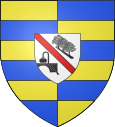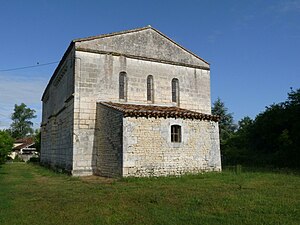Salles-d'Angles
| Salles-d'Angles | ||
|---|---|---|

|
|
|
| region | Nouvelle-Aquitaine | |
| Department | Charente | |
| Arrondissement | cognac | |
| Canton | Charente-Champagne | |
| Community association | Grand Cognac | |
| Coordinates | 45 ° 37 ′ N , 0 ° 20 ′ W | |
| height | 11-87 m | |
| surface | 21.80 km 2 | |
| Residents | 1,026 (January 1, 2017) | |
| Population density | 47 inhabitants / km 2 | |
| Post Code | 16130 | |
| INSEE code | 16359 | |
 Salles-d'Angles - Chapel of the former Commandery of the Templar Order |
||
Salles-d'Angles is a southwestern French municipality with 1026 inhabitants (at January 1, 2017) in the Charente in the region Nouvelle-Aquitaine .
location
The elongated double community of Salles-d'Angles - consisting of the two formerly independent villages Salles (in the north) and Angles (about 2.5 kilometers south) - is located at about 45 meters above sea level. d. M .; The River Né flows through the district of Angles . About 8.5 to 11.5 kilometers (driving distance) in a northerly direction separate the place from the city of Cognac ; Segonzac , the capital of the canton, is only about 12 to 14 kilometers to the east. The neighboring municipality of Gensac-la-Pallue is about 10 to 12 kilometers northeast.
Population development
| year | 1968 | 1975 | 1982 | 1990 | 1999 | 2006 | 2016 |
| Residents | 932 | 991 | 1119 | 1225 | 1127 | 1098 | 1035 |
At the first census in France in 1793, the place had 824 inhabitants; In the 19th century, until the beginning of the phylloxera crisis (approx. 1865–1885), which resulted in a significant decline in the population in almost all wine-growing regions of France, it was well over 1200 for many years.
economy
Agriculture and especially viticulture have always played an important role in the Charente villages. While cereals, vegetables and oilseeds ( sunflowers ) were mainly grown for their own needs, one could earn good money with the export of wine (later also brandy) to England, Scotland and other countries in Northern Europe, although the winegrowers with the less Part of the earnings had to be satisfied. Today the south bank of the Charente near Salles-d'Angles is part of the Grande Champagne location within the large Cognac wine-growing area.
history
Prehistoric and Roman traces have been discovered on the area of today's municipality. Perhaps as early as Gallo-Roman times, in any case since the Middle Ages, the area was populated, as evidenced by the 12th century chapel of the Commandery of the Templar Order in Angles and the 13th century church of Saint-Maurice in Salles. Nothing is known about the destruction during the Hundred Years War (1337-1453); Even in the years of the French Revolution there were no attacks on the Church. In 1856, the originally independent places Salles de Segonzac and the Commanderie d'Angles were merged into one municipality.
Attractions
- The peculiar building of the sacred space of the Templar Commandery, built from precisely hewn stone material, stands in the former cemetery of the Angles district; it has neither an apse nor a tower, but a simple bell gable, and is otherwise - comparable to the Templar chapel in the neighboring village of Châteaubernard - completely unadorned inside and out - nevertheless, the building has been classified as a Monument historique since 1986 . The Romanesque building from the middle of the 12th century was transferred to the Order of St. John by Clement V from the years 1307 to 1312 after King Philip IV had smashed the Templar Order by three papal bulls ; It has been used as a parish church since the 16th century at the latest and received a sacristy extension made of smaller and only roughly hewn stones. Originally the interior probably had an open roof structure (possibly with a suspended coffered ceiling); today's flat vault made of plaster of paris is an ingredient of later times.
- The single-nave Gothic church of Saint-Maurice is in the district of Salles; it dates from the 13th century, was destroyed in the Huguenot Wars (1562–1598) and rebuilt in the 17th century. The church has a straight end of the choir and has been recognized as a monument historique since 1991 .
- The former rectory and its beautiful garden date from the 2nd half of the 18th century and are now used as the town hall. House and garden have been on the list of historical monuments since 1991 .
- The time of construction of the double-arched bridge at Angles - slightly raised in the middle - is unknown - some date it to the Middle Ages, others to the 16th century. The bridge spans the river Né; the pillars are pointed on the upstream side to drain off floating debris. The bridge was classified as a Monument historique in 1986 .
- A museum ( Musée communal Gaston-Grégor ) is dedicated to the everyday life of farmers in the 19th century and shows agricultural and domestic tools. The simple living room and bedroom of a craftsman at the time of the French Revolution was recreated in one room .
- In the vicinity of the village there are several farms ( fermes ), barns ( granges ), windmills and water mills ( moulins à vent or moulins à eau ) and a wash house ( lavoir ), which are also of historical importance.
Individual evidence
- ^ Salle-d'Angles, Commanderie des Templiers in the Base Mérimée of the French Ministry of Culture (French)
- ^ Salle-d'Angles, Église Saint-Maurice in the Base Mérimée of the French Ministry of Culture (French)
- ^ Salle-d'Angles, Église Saint-Maurice in the Base Mérimée of the French Ministry of Culture (French)
- ^ Salle-d'Angles, Ancien Presbytère in the Base Mérimée of the French Ministry of Culture (French)
- ^ Salle-d'Angles, Pont in the Base Mérimée of the French Ministry of Culture (French)
- ↑ Salle-d'Angles and surroundings - barns, mills, etc.



